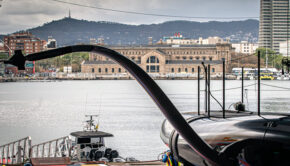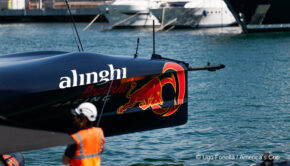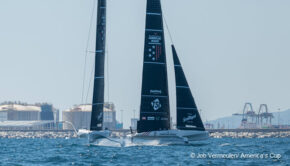How 37th America’s Cup will be won
Published on November 6th, 2023
With the summer sailing session in Barcelona drawing to a close, reflecting back on the period when the actual America’s Cup will race – 12th October through potentially to the 24th October 2024 – will be a study in meteorology and a deep dive into the sailor’s mindsets in order to build an AC75 that is capable of winning across a broad range of conditions.
What has surprised many commentators, and indeed the sailors themselves, is the variety of conditions that Barcelona serves up on any given day at this time of the year.
The sea state has also been something that all the teams have been grappling with and as October ended, with some of the Atlantic weather systems pushing in, there were waves up to two metres from a variety of angles plus the famously shifty breeze that occasionally blows in from the north-east.
Indeed, to look at the weather data that was reported by the Alinghi Red Bull Racing and Emirates Team New Zealand recon teams during the 11 days that the boats sailed between 11th October and the 27th October, there was a peak average wind speed of 15 knots and an average range of 8-15 knots for the period.
Only two days out of the eleven recorded showed wind peaks above 22 knots whilst on five days there was a peak wind strengths of 12-15 knots. Only one recorded day (October 22) saw wind speeds of 3-5 knots and on that day only the Kiwis ventured onto the water to test their lower end speed and flight capabilities.
Swell data averaged over the 11 days of the Swiss and Kiwi’s sailing sessions showed a mean range of 0.55-0.81 metre swells with only two days (October 23-24) where there were swells of 1.5 metres and above whilst only one day (October 11) saw flat conditions with less than 0.25 metres of swell.
The vast majority of days saw an average of 0.5 metres of swell building slightly into the afternoon. Temperature averages showed a pleasant 25° C with only two days dipping below 20 degrees – the ‘drysuit days’ as the sailors call them.
So with all that data in mind, what will the designers be looking for in their hull design?
Do they opt for the slab-sided muscle-car design of ‘Te Rehutai’ – the 36th America’s Cup winner – or will they look more towards the fresh INEOS Britannia ‘T6’ LEQ12 design with its wave piercing bow profile? Or perhaps something between the Dan Bernasconi designed ‘Te Aihe’ that is now Alinghi Red Bull Racing’s ‘BoatZero’ AC75 and the ‘Te Rehutai’ design?
Luna Rossa Prada Pirelli have had much success in Cagliari conditions with their baby ‘Te Rehutai’ LEQ12 design of ‘Luna Rossa’ and have not re-launched their AC75 from the last America’s Cup that proved so successful as a development platform through the round robins and then into the final.
Whatever design the computer simulations throw out, for the Challenger they will need a boat that is capable of getting through the round robins of the Louis Vuitton Cup (August 29-October 7) and then can be moded for the slightly fresher conditions that can reasonably be expected come the 37th America’s Cup Louis Vuitton Match.
Low flight will be absolutely key both upwind and downwind with some significant clues offered by the INEOS Britannia thinking as they modified their ‘bustle’ in Palma, Majorca and were able to really skim the surface with ‘T6’ and super-effectively end-plate the hull to the water.
This approach could well be copied elsewhere and as we saw as the summer progressed in Barcelona, the likes of Emirates Team New Zealand, NYYC American Magic and Alinghi Red Bull Racing were all instructing their Flight Controllers to go ever lower, even in marginal foiling conditions.
Ray Davies has one of the keenest eyes for the progression in yacht design and on the last day of sailing in Barcelona with ‘Te Rehutai’ he commented on the new designs being built at yards all over the world at the moment:
“They’ll certainly look a bit different. Everyone’s designs will be locked in now so it’s hard to imagine everyone is going to look the same and I think if they all look like that (pointing at ‘Te Rehutai’) they’ll be second generation boats. Life moves on and designs move on and we’re expecting some changes.”
Davies also talked about the variety of conditions and how valuable the training period through October has been for the Defenders of the 37th America’s Cup saying:
“It’s been absolutely critical for us to have come up here and experience Barcelona and the conditions and we have seen everything – we’ve seen perfectly flat 7 knot days where it would be incredible light air conditions and we’ve seen 21 knot days with big seas and everything in between and what we’ve learned is Barcelona can offer all of that up.”
Towards the end of October, Barcelona experienced the offshore breeze that filters down from the surrounding mountain ranges and over what is essentially a bowl where the city is located, and before hitting the racecourse is bouncing off various buildings and structures along the waterfront. How to sail in those conditions was summed up perfectly by the man they call the ‘wind whisperer’ Nathan Outteridge when he said:
“You’ve just got to go through a lot more gear changes, down the bottom of the course we had high teens and often at the top of the course sometimes you had high teens, sometimes you had like 8 or 9 knots, so a lot of what we were trying I guess to work out was just how quickly we can adjust the sail trim so that we can get through such a large range of conditions.
“It was shifting 45 degrees out there at times so you’re on like a glamour shift and you’re like ‘okay this is great’ and then you hit a boundary and you’re sailing kind of back where you came from. So, it was definitely good for us to be able to do that and I think we’ve all done a lot of sailing in shifty venues and when you’re in Barcelona for months on end and biggest shift you see is about 8 degrees it was nice to actually try and pick a couple.”
Interesting observations but invariably at this time of the year, the more stable ‘Garbi’ wind from the south-west prevails – interspersed with the ‘Xaloc’ (taken from the word ‘Scirocco’) from the south-east. The Garbi arises due to the divergence of temperatures between the sea and the land, which is why it usually appears during spring and summer, causing warm and dry air masses to move from the desert towards the southeast of Spain.
The other wind witnessed in Barcelona this summer was the easterly running ‘Levante’ – a more humid wind that brings clouds and rain to the coast of the Iberian Peninsula from the central Mediterranean and usually builds in strength through the afternoons.
The rare north-easterly breezes that Davies and Outteridge spoke about are the ‘Gregal’ that is a cold and dry wind that dipped the mercury below 20 degrees on the two days that Emirates Team New Zealand and Alinghi Red Bull Racing sailed their AC75’s into replete with full drysuits onboard.
Barcelona therefore is a fascinating design project for the teams and for the sailors. The wind limits for starting racing are between 6 knots and 21 knots so that’s a wide weather window to design to. The smart money is on the team that can build a boat with a sweet spot into the mean averages but can be moded for the extremes.
The wait now is until the Spring of 2024 to see what solutions the design and engineering teams deliver. Stay tuned.
Source: ACE
Following the publication of the AC37 Protocol and AC75 Class Rule on November 17, 2021, the AC75 Class Rule and AC Technical Regulations were finalized on March 17, 2022. The entry period opened December 1, 2021 and runs until July 31, 2022, but late entries for the 37th America’s Cup may be accepted until May 31, 2023. The Defender was to announce the Match Venue on September 17, 2021 but postponed the venue reveal, confirming it would be Barcelona on March 30, 2022. The 37th America’s Cup begins October 12, 2024.
Teams revealed to challenge defender Emirates Team New Zealand (NZL):
• INEOS Britannia (GBR)
• Alinghi Red Bull Racing (SUI)
• Luna Rossa Prada Pirelli Team (ITA)
• NYYC American Magic (USA)
• Orient Express Racing Team (FRA)
2023-24 Preliminary Regattas
September 14-17, 2023 (AC40): Vilanova i la Geltrú, Spain
November 30-December 2 (AC40): Jeddah, Saudi Arabia
August 2024 (AC75): Barcelona, Spain
2024 America’s Cup
August 29-October 7: Challenger Selection Series
October 12 – ?: 37th Match (Best of 13)
Additionally, 12 teams will compete in the 2024 Youth & Women’s America’s Cup.
Noticeboard: https://ac37noticeboard.acofficials.org/
Additional details: www.americascup.com/en/home









 We’ll keep your information safe.
We’ll keep your information safe.